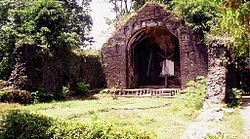List
| Image | Name | Location | Order | Structural type | Ref. |
|---|---|---|---|---|---|
 | Bacarra | Bacarra, Ilocos Norte | Augustinian | belfry | [1] |
 | Bancuro | Naujan, Occidental Mindoro | Augustinian | church | [2] |
| Bangahon Church Ruins | Gandara, Samar | church | [3] | ||
 | Banza | Butuan, Caraga | belfry | ||
 | Binongtoan | Carigara, Leyte | church | ||
| Budiao | Daraga, Albay | church | [4] | ||
 | Cagsawa | Daraga, Albay | Franciscan | belfry | [5] |
 | Dulag | Dulag, Leyte | church | ||
 | Dumaguete belfry | Dumaguete, Negros Oriental | belfry | ||
| Ermita | Dimiao, Bohol | church | |||
| Ermita | Dumangas, Iloilo | church | |||
 | Gui-ob | Catarman, Camiguin | church | [6] | |
| Igbaras | Igbaras, Iloilo | church | |||
 | Kuta | Bongabong, Occidental Mindoro | church | ||
 | Mangarin | San Jose, Occidental Mindoro | church | ||
 | Mataguisi | Pudtol, Apayao | church | [7] | |
| Maybato | Hamtic, Antique | church | |||
 | Nahulugang Kampana | Lagonoy, Camarines Sur | belfry | ||
 | Nassiping | Gattaran, Cagayan | church | [8] | |
| Nuestra Señora de la Escalera | Nasugbu, Batangas | church | |||
 | Old Taal | San Nicolas, Batangas | church | ||
 | Old Tanauan | Talisay, Batangas | church | [9] | |
 | Palapag | Palapag, Northern Samar | church | ||
 | Pasuquin | Pasuquin, Ilocos Norte | church | ||
 | Pata | Sanchez-Mira, Cagayan | Dominican | church | [10] |
| Pindangan | San Fernando, La Union | church | |||
 | Saint Augustine | Panglao, Bohol | church | ||
 | Saint Hyacinth | San Jacinto, Pangasinan | church | ||
| San Agustin de Hippo | Bantay, Ilocos Sur | church | |||
| San Diego | Silay, Negros Occidental | church | |||
| San Francisco de Asis | Tarangnan, Northern Samar | church | |||
| San Francisco de Assisi | Escalante, Negros Occidental | church | |||
| San Guillermo de Aquitania | Magsingal, Ilocos Sur | church | |||
 | San Jacinto de Polonia | Camalaniugan, Cagayan | church | ||
| San Julian de Cuenca | Janiuay, Iloilo | belfry | |||
 | San Pablo de Cabigan | Isabela | church | ||
| San Pedro | San Jose, Antique | Augustinian | church | ||
| Santa Barbara | Zumarraga, Samar | church | |||
| Santa Maria | Lal-lo, Cagayan | church | |||
| Santa Rosa de Lima | Bacacay, Albay | church | |||
| Seven Dolors | Hernani, Eastern Samar | church | |||
| Siaton | Siaton, Negros Occidental | church | |||
| Tabang | Santo Niño, Cagayan | church | |||
 | Tumbaga | Sariaya, Quezon | church | ||
| Tucalana | Lal-lo, Cagayan de Oro | church | |||
 | Santa Monica Church belfry | Cavite City | Augustinian Recollects | belfry | |
 | San Juan de Dios Church | Cavite City | Hospitallers of Saint John of God | church | |
 | Old Oton Church | Oton, Iloilo | Augustinian | church |